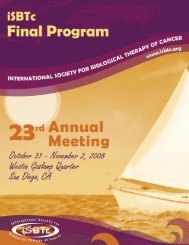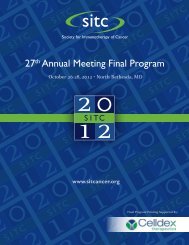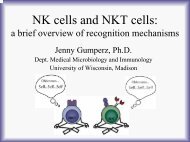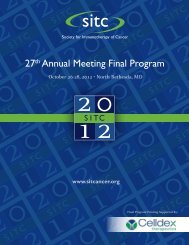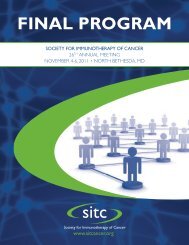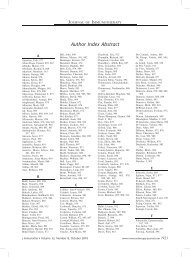Abstracts for the 25th Annual Scientific Meeting of the International ...
Abstracts for the 25th Annual Scientific Meeting of the International ...
Abstracts for the 25th Annual Scientific Meeting of the International ...
Create successful ePaper yourself
Turn your PDF publications into a flip-book with our unique Google optimized e-Paper software.
J Immuno<strong>the</strong>r Volume 33, Number 8, October 2010<br />
<strong>Abstracts</strong><br />
Generating T cells with specific reactivity against tumor-associated<br />
antigens is a key component <strong>of</strong> adoptive immuno<strong>the</strong>rapy. In our<br />
work, we have established lymphocyte cultures from tumorinfiltrating<br />
lymphocytes. After digestion, cells from a specific<br />
tumor are grown under different culture conditions such as IL-2,<br />
anti-OX40 mAb, NOS inhibitor+Arginase inhibitor, NOS inhibitor+Arginase<br />
inhibitor+OX40, IL-15+Low Dose IL-2, or IL-<br />
15+High Dose IL-2. We refer to <strong>the</strong> mixed cell population from<br />
each <strong>of</strong> <strong>the</strong>se tumor-culture conditions as CLOIDs. If a particular<br />
CLOID was successfully expanded over a 3 to 8 week period, that<br />
CLOID was in turn aliquoted and subjected to multiple stimulation<br />
conditions such as activation by autologous tumor, allogenic<br />
tumor, or anti-CD3. Each <strong>of</strong> <strong>the</strong>se aliquots were inspected by<br />
ELISA <strong>for</strong> <strong>the</strong> release <strong>of</strong> cytokines such as IFN-g, IL-5, and IL-17.<br />
Additionally, <strong>the</strong> T cell repertoire <strong>of</strong> each CLOID was examined by<br />
multiparameter flow cytometry <strong>for</strong> subphenotypes as defined by<br />
CD4, CD8, CD107a, CCR7, CD45RA, CD27 and CD28 mAb<br />
staining. Making sense <strong>of</strong> this complex data <strong>for</strong> multiple tumors,<br />
multiple culture conditions and multiple stimulation conditions is<br />
<strong>the</strong> challenge addressed here. We created a Rich Analytical<br />
Environment by integrating both <strong>the</strong> ELISA data and <strong>the</strong> flow<br />
cytometry data in a relational database. We also included relevant<br />
descriptive data such as source tumor and culture conditions. This<br />
approach gave us fast and reliable access to all data from <strong>the</strong> study.<br />
Then, we addressed relevant questions using a combination <strong>of</strong><br />
visual and statistical techniques. We were able to show that:<br />
For 8 <strong>of</strong> 9 tumors, <strong>the</strong>re were no statistically significant<br />
differences between <strong>the</strong> number <strong>of</strong> cells produced by tumor<br />
reactive CLOIDs (n = 156 total) digested with enzyme and<br />
those digested mechanically.<br />
For some tumors, CLOIDs digested with enzyme produced<br />
significantly more IFN-g than those digested mechanically.<br />
In tumors digested with enzyme, <strong>the</strong> autologous tumor-specific<br />
central memory (CCR7+CD45RA CD27+CD28+) and<br />
central memory-like (CCR7+CD27+CD28+) CD4 and<br />
CD8 T cell populations were significantly higher when cultured<br />
with IL-15 and low dose IL-2 than with high dose IL-2 alone<br />
(0.001< P



